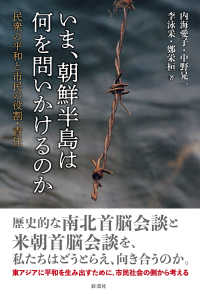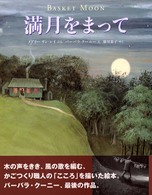- ホーム
- > 洋書
- > 英文書
- > Literary Criticism
Full Description
Essays discuss Ellison's relationship with the science fiction and fantasy community, his sense that mainstream critics slighted his work because it was identified with genre fiction or popular fiction, his easy postmodern accommodation of popular culture references and images, and his ambiguous standing in the literary establishment.
Unlike the other Critical Insights volumes on authors such as James Baldwin, F. Scott Fitzgerald, T.S. Eliot, Isabel Allende, or Arthur Miller, who tend to be viewed as part of the mainstream literary establishment, Harlan Ellison is generally considered a popular author of science fiction, speculative fiction, fantasy, mystery, and horror.
Ellison, like virtually all science fiction and fantasy writers, is not such a ""bestselling"" writer. And although the occasional author has achieved a ""singular"" bestseller (such as Vladimir Nabokov's Lolita in 1955), Ellison is not one of them despite his wide readership. Ellison is part of an equivocal field (science fiction and fantasy) as seen by the mainstream literary community, but he is also seen by the science fiction and fantasy community itself as an equivocal member.
Another misconception about Ellison is that since he wrote some science fiction (and because science fiction today in film and television is incredibly popular), he must be a bestselling author like Stephen King. But in fact (with two or perhaps three main exceptions) virtually no science fiction author has often been on the bestseller list for his own original conceptions.
Among science fiction, only two writers, both now dead, often wrote bestsellers: Kurt Vonnegut, Jr. the author of Slaughterhouse-Five in 1969, and Michael Crichton, creator of The Andromeda Strain (1969).
This volume addresses Ellison's push-pull relationship with the science fiction and fantasy community, Ellison's sense that mainstream critics slighted his work because it was identified with genre fiction or popular fiction (and he was so labeled), his easy postmodern accommodation of popular culture references and images, and his ambiguous standing in the literary establishment.
One possible reason Ellison is popular is the readers' sense that his works are often moral parables, with strong social concerns and cautionary themes about technology. These ideas are expanded on in this volume. Ellison can be viewed as producing a Sartre-like ""engaged literature,"" in which the ""authentic"" individual strives to fight oppression, accept responsibility for his actions, and steers toward freedom in a social context, with an eye toward moral responsibility.
Some of Ellison's enduring attraction is in ideas of rebellion against conformity, revolt against constrictive authority, and imaginations of disaster that fit their new historical context. Another reason young readers and students today still have such a strong reaction to Ellison's fiction may lie in its sheer postmodern newness. One essay here pointedly compares and contrasts Ellison's vision of dystopian hell with that of Cormac McCarthy's. It may be the bleak, minimalist, Beckett-like vista of the inferno shakes a person up and appeals to the apocalyptic imagination. In addition there may also be other postmodern appeals: unconventional typographical and lexical innovations, edgy satire, black humour, and parody, magic realism and metafiction, experiments with alternate ways of storytelling and of using points of view, pop culture references and fragmented narrative, and a general sense of freedom and improvisation in the stories. All of these elements of mainstream postmodernism seem to have, at one point or another, filtered down into Ellison's landmark fiction.
Young readers may enjoy the tone of comic absurdism and edgy satire (as in, say, Kurt Vonnegut too), even if they don't fully recognise the references.
Another way to explain the appeal of Ellison's work is to examine the underlying mythological and psychological themes as essays included here do. One examines the consciously designed mythic structures of the book Deathbird Stories, which relates urban tales of gods and devils, ancient and modern. Another compares Edgar Allan Poe and Harlan Ellison in regard to the alienated outsider figure, both as author and as character, who attempts to reach the supreme, sublime moment of transcendence.
There may be other explanations for the appeal of Ellison's fiction but these new essays, in addition to the reprints of classic essays on Ellison's most famous stories, will provide a sufficient starting place for appreciating the work of Harlan Ellison—an author who has written for over half a century and has certainly paid his dues.
Each essay is 5,000 words in length, and all essays conclude with a list of ""Works Cited,"" along with endnotes. Finally, the volume's appendixes offer a section of useful reference resources:
A chronology of the author's life
A complete list of the author's works and their original dates of publication
A general bibliography
A detailed paragraph on the volume's editor
Notes on the individual chapter authors
A subject index
















